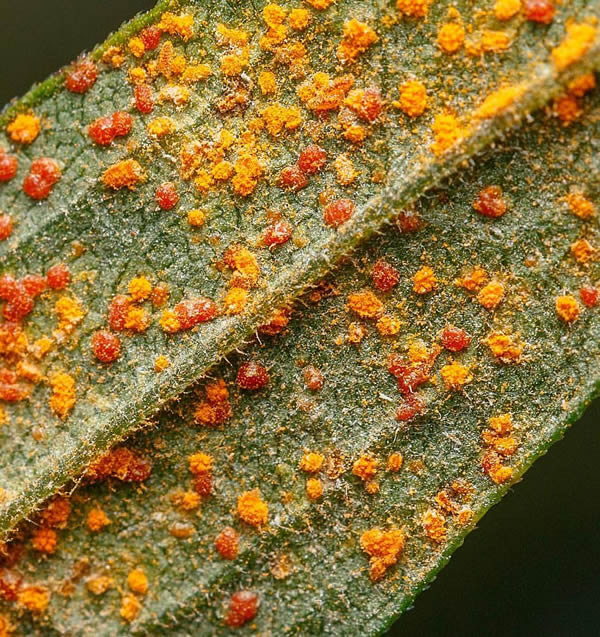 |
| Parasitic plants, lovevine embrace (Cuscuta spp.) |
Parasitic plants are those symbiotic life-forms that form mutualistic relationships with other plants at their hosts’ expense.
The more is learned about plants and other organisms, the more apparent it is that many, if not most, plants are involved in symbiotic associations in which one or more other organisms live in close interaction with the plant—almost as if they are one. Symbiosis is frequently thought of as being a mutualistic relationship in which both the plant and its symbiont benefit.
Typical examples include the alga and fungus that make up a lichen and the bacteria living in a legume root nodule. Commensalistic relationships, such as Spanish-moss hanging from a live oak, are less commonly thought of; in this relationship, one plant obviously benefits, while the other seems to be little affected.
  |
Parasitism is the third symbiotic condition, in which one plant benefits, but the other is harmed. Fungi are by far the most common parasites of plants; the study of these fungi is a major component of the science of plant pathology. Less common, but frequently well known, are some flowering plants, such as mistletoe, that parasitize other plants.
Haustorium
The defining feature of parasitic plants is the presence of a haustorium. The concept of a haustorium is broadly defined as a structure formed by the parasite to connect it physiologically to its host—a morphological/physiological bridge.
The haustorial organ may be a simple outgrowth and proliferation of tissue, or it may be an elaborate, highly organized structure. Its appearance is often a useful diagnostic feature.
Typically, the haustorium serves three functions: to attach the parasite to the host (adhesion), to penetrate into the host tissue or even into individual host cells (intrusion), and to conduct water and nutrients from the host to the parasite (conduction).
Fungal Parasites
 |
| Fungal Parasites |
Fungal parasites are among the most destructive diseases of plants. (Some, such as athlete’s foot, can affect animals.) Parasitic fungi occur in each of the fungal divisions.
They can have tremendous economic impacts. For instance, rust fungi, members of the Basidiomycetes, infect every species of cereal grain and can reduce yields by as much as 25 percent.
In addition to their direct economic impact, parasitic fungi have historically had profound social effects. In the 1800’s outbreaks of Phytophthora infestans, late blight, decimated the potato crops of Europe just prior to harvest.
This oomycete first turned the potato leaves and stems to mush and then infected the tubers. As a result, millions of people who depended on potatoes as their primary source of food starved to death. Ireland was particularly hard-hit, and millions emigrated from there.
Some fungal parasites have a mixed impact on humans. The genus Claviceps, an ascomycete, infects cereal grains, producing structures called ergots. A variety of alkaloids are produced in the ergot tissue that causes ergotism in animals that eat infected grain. Symptoms include convulsions, psychotic delusions, and gangrene.
It has been suggested that the Salem “witches” executed in colonial Massachusetts or their “victims” were suffering from the effects of eating ergotted grain. Today ergot is the source of vasoconstricting drugs used in medicine to control bleeding and relieve migraine headaches.
Angiosperm Parasites
 |
| Angiosperm Parasites |
While most mistletoes are tropical, the two mentioned above are common in the temperate regions. Unlike many parasitic flowering plants, mistletoes are green and photosynthetic and can thus produce their own food.
Many species, including the Christmas mistletoes, produce fleshy, rigid mature leaves, but in other species the leaves are reduced to scales. Most species are epiphytic and grow in the branches of a host tree. Some tropical species are terrestrial, and at least one forms a 30-foot-tall tree.
Even these tree species form a characteristic haustorium connecting the parasite to the host. Mistletoes cause severe economic losses inmany areas. For instance, dwarf mistletoe (Anceuthobium) attacks many gymnosperms in the southwestern United States, particularly ponderosa pine.
Another well-known flowering plant parasite is dodder (Cuscuta). Dodder is distributed worldwide. It is easily recognizable because its rapid growth can quickly cover a host plant with a network of yellowish stems and scale like, yellow leaves.
   |
Although dodder seeds germinate on the ground, the root disintegrates as soon as haustoria make connections with a host, at which time the dodder becomes completely dependent on the host for nutrients. Dodder is designated as a noxious weed throughout the continental United States.
Origin of Parasitism
It is generally believed that parasites evolved from“normal” plants. As haustoria developed and became more specialized, structural parts and physiological processes normally associated with support and nutrient assimilation were reduced until they were no longer capable of supporting the plant, which became dependent on its parasitic habit.
For instance, within the mistletoe family there is a complete gradient from terrestrial root-parasites, in which the roots of the tree-mistletoe parasitize the roots of host plants, to epiphytic shoot parasites, which are completely dependent on their host.
This gradient suggests that the epiphytic forms evolved from terrestrial species through increasing specialization of the haustorial organs and reduction of roots and leaves.
The visible effects of a parasite on its host ranges from spectacular alformations, such as “witches’ brooms” (a proliferation of short branches by the host at the site of parasite attachment), to no discernable effect. The physiological effects are also variable.
While all parasites weaken their host to some degree, in some cases the effect is hardly discernable. This makes sense because it would not be advantageous for the parasite to so weaken its host that the host dies. Nevertheless, this extreme is also evident, as described above for late blight of potato.